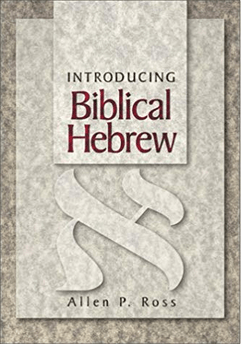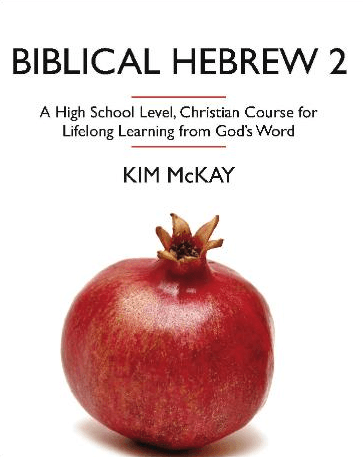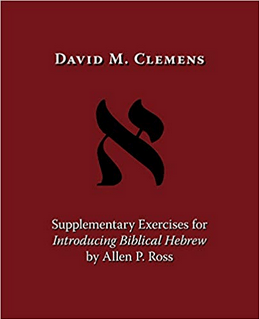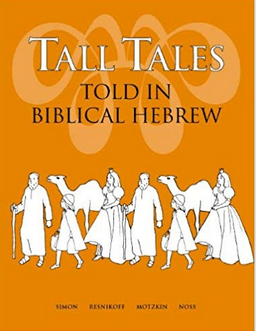hebrew grammars

Dr. John H. Sailhamer was our first professor of Hebrew, and you can read more about his influence on us on the About Us page. His Grammar of Biblical Hebrew has never been published, but we used it while attending his classes at Southeastern Baptist Theological Seminary. It was not completely refined for publication, but is still a valuable resource. Particularly in the matter of Hebrew verbs, Dr. Sailhamer teaches an approach that is not wide-spread, but is well researched and makes sense when applied to the text. His system of charts for memorizing the “nuts and bolts” is also the most orderly and comprehensive of any we have seen. We offer a FREE PDF version in our Shop.
Dr. Sailhamer also recommended the grammar Introducing Biblical Hebrew by Allen P. Ross. There is an accompanying workbook entitled Supplementary Exercises for Introducing Biblical Hebrew, (reviewed below). As a supplement to Ross’s grammar, search “Ross Audio files” at www.biblicallanguages.net or click here to go directly to the page. You can hear the Hebrew vocabulary words from the grammar pronounced.
We have also been using Learning Biblical Hebrew: A New Approach Using Discourse Analysis by B.M. Rocine. It was designed to be able to stand alone without an instructor/classroom, (a “teach yourself” approach) which makes it very useful in a homeschool setting or if you do not have access to a Hebrew scholar. It is also unique in teaching beyond a sentence-level understanding to look at the scope of the language in narrative, (called discourse analysis). If you follow the link above, the book description provides more details. You may also purchase this as a downloadable file, (for $8 less than the physical copy).
Its instructional method uses a Bible verse per lesson and teaches the Hebrew necessary to translate that verse. This necessitates a slightly scattered introduction of material, mixing instruction on nouns, verbs, particles, etc. For my learning and teaching style, it was better to begin with a grammar that tackled each part of speech in-depth and successively, (as is done in Introducing Biblical Hebrew or Biblical Hebrew 2) and use the Rocine grammar as a reinforcement and exercise book. However you use it though, its discourse analysis approach makes it a must-have in your library.
Biblical Hebrew 2 is less technical in its teaching, but that is appropriate for the high school level, (the grammars recommended above are written for college or graduate level students). It is an excellent grammar option for someone who is intimidated to begin studying an ancient language with “strange” letters, or it would be a profitable compliment to one of the more advanced grammars, (particularly because of its supplemental material, discussed below). There are three volumes that can be purchased separately: the text book, (containing the supplemental reading) a workbook, and workbook answer key. It is written from a Christian perspective.
Biblical Hebrew 2 does not assume the student has knowledge of basic English grammar, and each Hebrew part of speech is defined and examples in English are given. However, it does require thorough mastery of the names of the Hebrew letters and vowels, as it often references them by name without using the Hebrew character. The answer key format is extremely convenient; it is an exact replica of the workbook, with the answers written beside the questions. This greatly facilitates teaching/guiding a student, even by a teacher without any knowledge of Hebrew. Kim McKay places fitting emphasis on the valuable skill of smooth verbalization, and translation begins in week three. Unique among Hebrew grammars, each chapter includes supplemental reading that enfleshes the (sometimes) dry bones of learning a language. This reading includes manuscript history, archeological discoveries, introduction to text criticism, and Hebrew literary features, among many other things.
While BH2 cannot be a one-stop grammar, (due to the missing technical details mentioned above) you cannot go wrong with starting here. It will launch you well on your way to knowing and loving Hebrew.
hebrew workbooks
We have not yet used this workbook, and so here is the publisher’s blurb:
This Supplement is intended to provide a diverse and extensive range of additional practice material for use in mastering the grammatical content of Introducing Biblical Hebrew by Allen P. Ross. It is based upon the writing system, vocabulary, morphology and syntax of Biblical Hebrew as these are presented in Introducing Biblical Hebrew, running parallel to the first 41 chapters of that volume.
Published by Aleph Press, who also produced Biblical Hebrew 2, (reviewed above). Jonah is an excellent book with which to begin translation practice because its Hebrew is very simple. Every page of this workbook has two verses, and every line of text is in chart form, with each word in its own box. The top row of boxes contain the Hebrew words, underneath are blank spaces for writing translations, and the bottom row has the English meanings. The student could cover the English until they have written their own translation, and then uncover the English to check their work. At the bottom of each page is a space for writing a smooth English translation of the verses.
This is a very simple workbook, as the only other information in it is the Aleph Bet chart and the vowels chart at the back of the book. However, it presents a very orderly format to facilitate early practice of the skill of parsing and translating.
The Graded Reader was designed for use after the first year of Hebrew instruction. The verses chosen for translation are ordered according to the books of the Hebrew Bible, and also progress from simpler Hebrew to more complex grammatical constructions. At the end of each translation exercise, there is a section entitled “Grammatical Commentary” that explains the reasons behind the correct translation. This commentary reinforces beginning Hebrew grammar and introduces intermediate concepts. The grammar terms used are the technical ones taught in the college-level grammars. At the very end is a Parsing Answer Key for all the verbs.
My thanks to the folks at Aleph Press for bringing this workbook to my attention. The concept of using stories that children know intimately as fodder for Hebrew translation is brilliant. It provides a fresh and interesting alternative to translating single verses or parts of verses from the Bible. Its nineteen fairy/folk tales progress from very simple Hebrew to slightly harder with each story. There is a “Word Bank” at the very beginning with 71 common Hebrew words that the student must be thoroughly acquainted with before beginning. Before each tale, the new vocabulary words, phrases, and grammar concepts that are included in that tale are outlined. At the back of the book are full English translations of each story that act as an answer key.
There is no convenient place in the book to write, but our children have used this book for copywork as well, writing the Hebrew on another sheet of paper, with their translations underneath.
more books for your hebrew library
This is the standard text for all Hebrew scholars of today. It is an exact copy of the Masoretic text as recorded in the Leningrad Codex. In scholarly circles it is known as BHS. Note that this book is sold in two different sizes—a short, fat one, (less expensive) and a larger version that costs a little more but the text does not feel as crowded.
Definitive lexicon for Hebrew studies, coded with Strong’s Concordance numbers. Known in those same scholarly groups as BDB. Learning to use this book is an essential skill for being an independent reader of the Hebrew Bible.
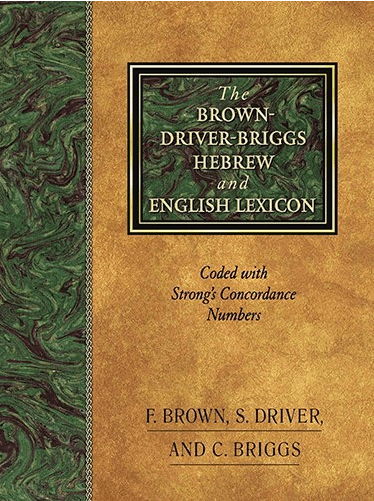

Authors: A. Philip Brown II, Bryan W. Smith
A jewel for facilitating smooth reading of the Hebrew Scriptures! Uses BHS text, but all words that occur less than 100x are glossed at the bottom of the page with the foremost of scholarly lexicons: BDB and HALOT, (The Hebrew and Aramaic Lexicon of the Old Testament). Also, proper nouns are screened in gray for immediate identification. These features enable uninterrupted reading of the Hebrew Bible at a much lower skill level, giving encouragement and incentive for further study to students.
This version includes only the Old Testament, but the books are arranged according to the original order in the Hebrew Bible. We love this book! If you can only purchase one book, GET THIS ONE!



